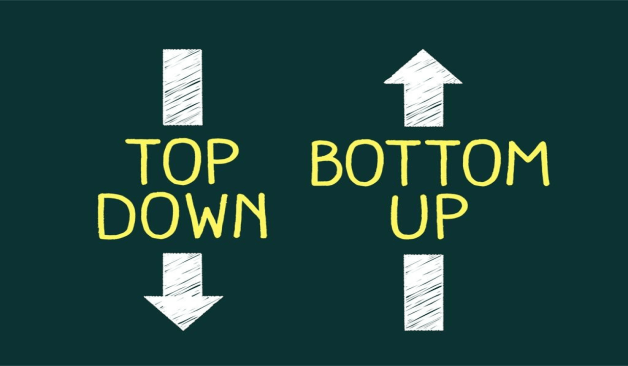
What is top-down and bottom-up investing?
Investing is a complex process, and there are many reasons for it. One of the top reasons is that there is no single success formula. Mr X would have made 20% annualized returns in the past 10 years. However, if you ask him to give you his success formula, he may fail to do it. If he does share, it may not work for you. Why does it happen? The market situation changes at a super-fast speed. Not only this but how investors look at the market and economy varies from investor to investor.
Are we trying to imply that there is no success formula to follow and that we should leave our investments to faith? No. The keyword you may have missed is 'single'. If you want to reach point M - which denotes wealth, you can get there via A -> T -> O -> M. Your friend can get to point M via P -> Q -> D -> M.
The essential thing to note is that you can only reach point M if you start and explore different options in investing, which can help you reach your desired goal of wealth creation. In today's article, we will learn about two prominent approaches to investing: top-down and bottom-up.
Top-Down Investing
Top-down investing is a macroeconomic approach to investing. In this strategy, you analyze the broader economic environment and market conditions before selecting specific investments. Here are the key steps in the process of top-down investing:
- Economic Analysis: If you want to adopt this investment, you start by examining the overall economic landscape. It will include factors like GDP growth, inflation & interest rates, and government policies. Your aim is to identify trends and potential risks that could impact various industries and sectors.
- Sector Selection: After assessing the macroeconomic conditions, in top-down investing, you identify sectors or industries that are expected to perform well in the given economic environment. For example, during a period of economic expansion, you might favor industries like technology or consumer discretionary, which tend to thrive in such conditions.
- Stock Selection: Once the sectors are chosen, you drill down further to select specific stocks within those sectors. The most important part of the process is to analyze individual companies within the chosen sectors to identify those with strong growth prospects, solid financials, and competitive advantages.
- Portfolio Construction: Finally, you construct a portfolio that aligns with the macroeconomic outlook and sector preferences. Please ensure that your portfolio includes a mix of stocks. Not only this, you must have bonds and other assets, with the allocation determined by your macroeconomic views.
Why choose a top-down approach?
Below are the top three advantages of top-down investing:
- It provides you with a structured approach based on economic data and trends.
- It helps you avoid industries or sectors that are likely to underperform in the current economic environment. One of the most important things for investors is to ensure the portfolio downside is minimal, and by avoiding underperforming industries, you do exactly that.
- The approach allows for diversification across various sectors and asset classes.
Bottom-Up Investing
Bottom-up investing, in contrast, is a microeconomic approach - a reverse of top-down. In this approach, your focus is to analyze individual stocks or assets rather than considering macroeconomic factors first. Below are key steps in bottom-up investing:
- Company Analysis: You start bottom-up investing by researching and evaluating individual companies. It involves assessing financial statements, competitive positioning (moat), management quality, and growth prospects.
- Valuation: The next essential step in the process is to determine the intrinsic value of a company's stock. For evaluation, you use many factors like earnings, cash flow, and growth potential. It helps you identify whether a stock is undervalued or overvalued.
- Risk Assessment: In bottom-up investing, you also consider specific risks associated with the company, such as industry competition, regulatory challenges, or operational risks.
- Portfolio Construction: After selecting individual stocks that meet their criteria, you build a portfolio based on the merits of these stocks, regardless of the prevailing economic conditions or sector trends.
Why choose the bottom-up approach?
Below are the top three advantages of bottom-up investing:
- It offers a detailed analysis of individual investments, leading to a deep understanding of the companies in the portfolio.
- You uncover hidden gems or undervalued stocks that may not be apparent through a top-down approach.
- You are less dependent on macroeconomic conditions, making it suitable for stock pickers focused on individual companies.
Which is better? Top-down or bottom-up
Like in investing, there is no universal formula for success. Similarly, there is no single, straight answer to this question. However, to give you some idea, you can go with top-down investing if you have a shorter investment horizon and can make frequent adjustments to your portfolio.
You can go with a bottom-up approach when you have the time and enjoy researching and analyzing individual companies. You chose this approach because you have a longer investment horizon and are willing to hold stocks for the long term.
To Sum Up
Top-down and bottom-up investing are two distinct approaches to investing. Each has its merits and applications. The choice between these strategies depends on an investor's goals, risk tolerance, and investment philosophy.
For someone new to investing, the best approach may involve a combination of both top-down and bottom-up strategies. For example, you could use a top-down approach to determine your broad asset allocation and sector preferences based on the economic environment, and then employ a bottom-up approach to select individual investments within those sectors. If you do so, you can benefit from the macroeconomic perspective and the detailed analysis of individual companies.










